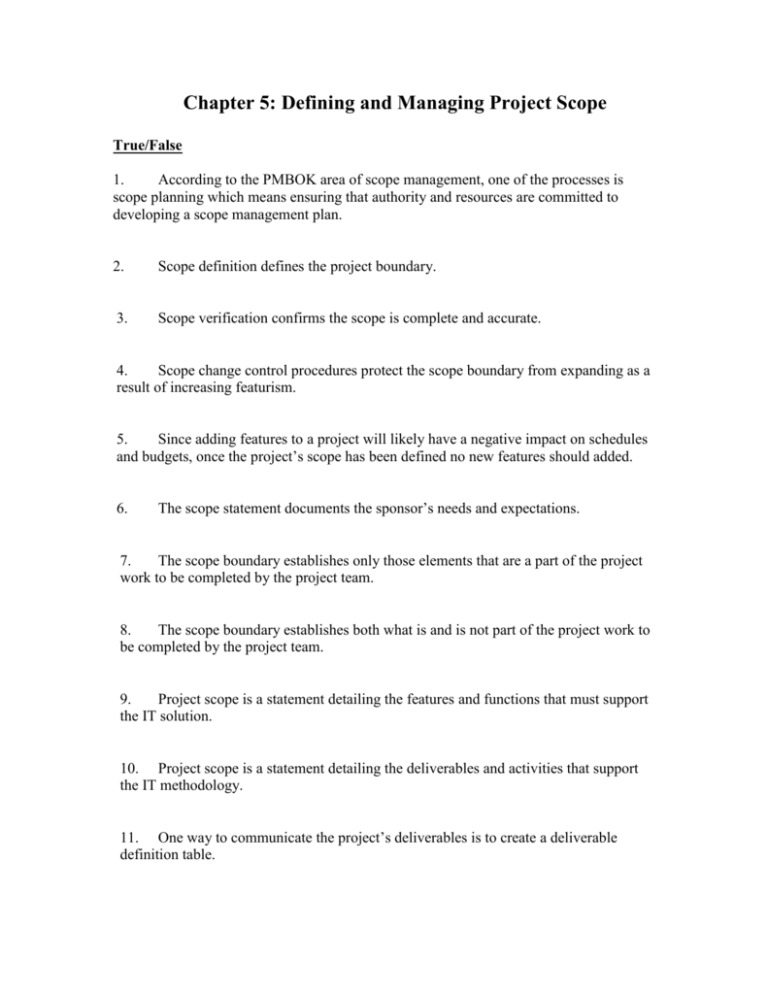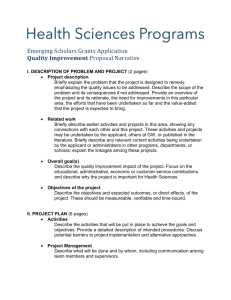Chapter 5: Defining and Managing Project Scope
advertisement

Chapter 5: Defining and Managing Project Scope True/False 1. According to the PMBOK area of scope management, one of the processes is scope planning which means ensuring that authority and resources are committed to developing a scope management plan. 2. Scope definition defines the project boundary. 3. Scope verification confirms the scope is complete and accurate. 4. Scope change control procedures protect the scope boundary from expanding as a result of increasing featurism. 5. Since adding features to a project will likely have a negative impact on schedules and budgets, once the project’s scope has been defined no new features should added. 6. The scope statement documents the sponsor’s needs and expectations. 7. The scope boundary establishes only those elements that are a part of the project work to be completed by the project team. 8. The scope boundary establishes both what is and is not part of the project work to be completed by the project team. 9. Project scope is a statement detailing the features and functions that must support the IT solution. 10. Project scope is a statement detailing the deliverables and activities that support the IT methodology. 11. One way to communicate the project’s deliverables is to create a deliverable definition table. 12. The development of a deliverable structure chart is an interim step to define detailed work packages used to estimate the project schedule and budget. 13. The development of a work breakdown structure is an interim step to define detailed work packages used to estimate the project schedule and budget. 14. Product scope is a statement detailing the deliverables and activities that support the IT methodology. 15. Actors are people or external systems that are elements of a data flow diagram (DFD). 16. The use case diagram, a feature of the UML, is useful for defining the product scope. 17. Scope grope suggests a fundamental and significant change in the project scope. 18. Joint application development is a group-based method where end users define the system requirements or design the system. 19. Joint application development is a group-based method where users and systems analysts jointly define the system requirements or design the system. 20. Scope change control is concerned with ensuring that any changes to the project scope will be beneficial, with determining that an actual scope change has occurred, and with managing the actual changes when and as they occur. Multiple Choice 1. Which of the following components or processes of a scope management plan most directly deals with the problem illustrated by a project team that spent a great amount of time on a set of activities that did not support the project MOV? a) Scope Planning b) Scope Definition c) Scope Boundary d) Scope Initiation e) Scope Verification Answer: 2. Which PMBOK® defined process within the knowledge area of project scope management confirms the project's scope is complete and accurate? a) Project scope initiation b) Scope planning c) Scope definition d) Scope verification e) Scope change control Answer: 3. Which PMBOK® defined process within the knowledge area of project scope management gives the project manager the authority to define the scope of the project? a) Project scope initiation b) Scope planning c) Scope definition d) Scope verification e) Scope change control Answer: 4. Which PMBOK® defined process within the knowledge area of project scope management is responsible for setting the scope boundaries? a) Project scope initiation b) Scope planning c) Scope definition d) Scope verification e) Scope change control Answer: 5. Which PMBOK® defined process within the knowledge area of project scope management protects the scope boundary from expanding as a result of increasing featurism? a) Project scope initiation b) Scope planning c) Scope definition d) Scope verification e) Scope change control Answer: 6. Which PMBOK® defined process within the knowledge area of project scope management identifies project deliverables? a) Project scope initiation b) Scope planning c) Scope definition d) Scope verification e) Scope change control Answer: 7. The concept of actors is an integral part of: a) data flow diagram. b) use case diagram. c) joint application development session. d) deliverable structure chart. e) deliverable definition table. Answer: 8. The term scope creep is best described as: a) a project team's inability to define the project's scope. b) a fundamental change in project scope. c) the project slowdown caused by changes in the project MOV. d) increasing featurism. e) a scary mouthwash salesman. Answer: 9. According to the text side bar on myths of scope management, which of the following statements expresses reality rather than myth. a) User involvement will result in an IS project grounded in the realities of business needs. b) A scope statement will clearly define what a project will do. c) Once the scope of the project is defined, hold firm because any deviation from the original plan is a sign that the project is out of control. d) Scope problems go beyond additional user demands. Scope changes will affect schedule, budget or both. e) Regular and frequent meetings with senior management will ensure they are kept up to date and will result in goodwill and support. Answer: 10. Which of the following is a product-oriented scope definition tool? a) Context level data flow diagram b) Deliverable structure chart c) Deliverable definition table d) Work breakdown structure e) None of the above Answer: Short Answer Questions (from end of chapter Review Questions) 1. What is meant by project scope? 2. Briefly describe the five scope management processes. 3. What is the project’s scope initiation process? When does it occur? Why is it important? 4. How does the IT project methodology support a project’s scope initiation process? 5. Briefly describe the scope planning process. 6. Briefly describe the scope definition process. 7. Briefly describe the scope verification process. 8. Describe the scope management plan in Figure 5.1. 9. Why is it important to define the project’s scope accurately and completely? 10. What is a scope boundary? What purpose does it serve? 11. What is the difference between product-oriented deliverables and projectoriented deliverables? 12. How does a project’s scope support the MOV concept? 13. What is a scope statement? What purpose does it serve? 14. What is a context dataflow diagram (DFD)? What purpose does it serve? 15. How does a use case diagram help to define the project’s scope? 16. What is a deliverable definition table (DDT)? What purpose does it serve? 17. What is a deliverable structure chart (DSC)? How does it map to a deliverable definition table (DDT)? 18. What is a work breakdown structure (WBS)? How does it map to the DDT and DSC? 19. Briefly describe what must be included in a scope verification checklist? 20. What is the purpose of verifying a project’s scope? 21. What is the purpose of scope change control procedures? 22. Briefly describe scope grope. 23. Briefly describe scope creep. 24. Briefly describe scope leap. 25. What are the benefits of having scope control procedures? 26. Briefly describe what should be included on a scope change request form. 27. What is the purpose of a scope change request log? Essay 1. Identify and briefly describe the five processes that support project scope management. 2 Why is it important to ensure the project’s scope has been defined completely and accurately? 3. What is the relationship between the project’s MOV and the project’s scope? 4. What is increasing featurism and what are the impacts it has on a project? 5. What is the purpose of a scope statement? Give an example of a scope statement that might address the needs of an organization that is looking to establish their first Internet web site. 6. What is project oriented scope and what are some of the commonly used tools to support it? 7. Describe product oriented scope and the tools that are available to support it. 8. What is project scope verification and why is it an important part of project scope? 9. The text describes three project problems with metaphorical names that scope change control is concerned with. Name and describe these problems and then illustrate how scope change control can ameliorate or remedy the problem. 10. In developing a scope change control form, what elements should be included and why?






